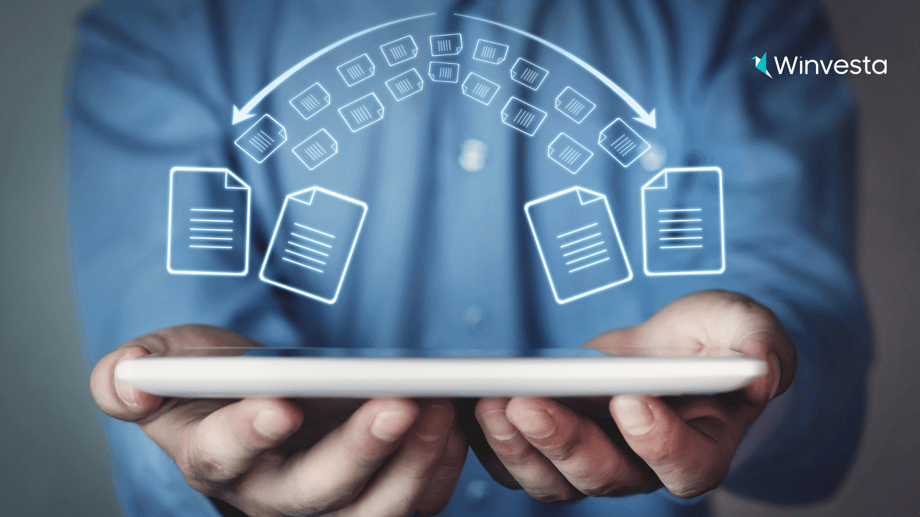Contents
How ACH transfers work: Step-by-step process for businesses and individuals
7 minutes read
12 July 2025

You're about to pay rent, schedule vendor payments, or send money to a friend, but you don't want to deal with paper checks, high transaction fees, or waiting in line. More people and businesses are turning to electronic payments that are fast, safe, and dependable. One of the most widely used methods? ACH transfers.
If you've ever seen "ACH" on your bank statement, you're not alone in wondering what it means. ACH transfers are everywhere—from your employer's payroll to automatic utility bills. But for many people, the process behind it remains a mystery. How does an ACH xfer move money from one account to another? How long does it take? Why do so many businesses use it instead of card payments or wire transfers?
Whether you're trying to make personal payments more efficient or looking for a better way to handle business transactions, understanding how ACH transfers work can make a big difference. The good news? It doesn't have to be complicated.
In this blog, you'll learn what ACH transfers are, how the automated clearing house transfer system powers them, and who uses them daily. We'll walk you through the whole process—from start to settlement—so you know exactly what happens when you send or receive an ACH payment. You'll see how ACH compares to wire transfers, when each is a better fit, and what steps you need to set one up for personal or business use—all in clear, simple terms.
Understanding ACH transfers and the system behind them
What is the Automated Clearing House network?
The Automated Clearing House (ACH) network is a U.S.-based system that facilitates the electronic transfer of funds between bank accounts. It's overseen by Nacha (the National Automated Clearing House Association) and processed through the Federal Reserve or private processors. Instead of transmitting money immediately or individually, the network handles batches of payments multiple times a day.
Think of the ACH network as a clearing system where banks send and receive recorded payment instructions across accounts. The funds are then settled behind the scenes. Each day, millions of these recorded transactions include everything from employee direct deposits to mortgage payments.
This setup is efficient and low-cost, which is why many institutions use it. In 2023 alone, the ACH network processed over 31 billion payments totalling more than $80 trillion. That's more than credit cards, checks, or wire transfers in volume.
What does ACH transfer mean?
An ACH transfer is the movement of money using the ACH network. It comes in two basic types: direct deposit (when money is added to your account) and direct payment (when funds are pulled from your account). Both rely on bank-to-bank communication using routing and account numbers.
For example, if your employer sends your salary via ACH, that's a direct deposit. If you pay your electric bill online and the utility company pulls money directly from your account, that's direct payment. Neither involves cards, cash, or checks.
ACH transfers are known for being more affordable than wire transfers, especially for recurring transactions. That's why banks and businesses often prefer them for salary, benefits, or subscriptions.
Who uses ACH payments?
ACH payments are part of everyday banking for millions of users across sectors. Here's who relies on them:
- Businesses using ACH for payroll, supplier payments, and subscription billing
- Government agencies issuing Social Security, tax refunds, and stimulus payments
- Consumers paying rent, utilities, loans, or splitting bills with friends
Large companies like Netflix and Amazon use ACH to collect recurring fees. Small businesses use it for cost savings. People use it to pay credit cards or transfer money between checking and savings accounts.
Now that you know what ACH transfers are and who uses them, let's break down exactly how the process works, step by step.
The step-by-step ACH payment process explained.
%20-%202025-07-12T123937.949.png?width=1600&height=900&name=Blog%20images%20(2)%20-%202025-07-12T123937.949.png)
Initiating an ACH transfer
Whether you're paying a vendor or sending money to a friend, every payment via ACH starts with authorisation. You must first provide permission for the transaction, either as a payer or a recipient.
For individuals, this might mean linking your bank account in an app like Venmo or filling out a direct deposit form at work. Businesses often collect authorisation via online checkout or signed agreements from customers.
The initiating party—called the Originator—instructs their bank (the Originating Depository Financial Institution or ODFI) to process the transaction. This includes the amount, date, and the recipient's bank account and routing number.
The ODFI groups your transaction with others into a batch file and submits it to an ACH Operator—either the Federal Reserve or The Clearing House.
Clearing and processing
Once the ACH Operator receives the batch file, it sorts the transactions by the destination bank or credit union. It then sends the appropriate records to the Receiving Depository Financial Institution (RDFI), which holds the recipient's account.
Unlike real-time payments, ACH transfers operate in scheduled batches. Most banks process these batches three times daily. So if you send a transaction late in the day or just before a weekend, processing may be delayed.
The ACH network validates transaction details to prevent errors or fraud, including account number format, routing info, and sufficient funds. During this stage, no funds have moved yet—just the payment instructions are being shared.
Settlement and completion
On the settlement date, the actual funds move from the sender's bank to the recipient's. This usually takes one to two business days, but can happen on the same day for eligible ACH transfers.
For example, if you send payment via ACH on Monday morning, your recipient will often see the deposit by Tuesday. Same-day ACH can settle funds within hours—usually by end-of-day—if initiated before the deadline (typically 4:45 PM ET).
Once settled, the funds are available in the recipient's account. The transaction is complete, and both banks archive the records.
Understanding how processing and batching work also helps when comparing ACH vs wire transfers, which we'll cover next.
Comparing ACH transfers and wire transfers
Processing speed and cost comparison
One of the most significant differences between an ACH transfer and a wire transfer is speed and cost. ACH transfers usually take one to two business days, while domestic wire transfers are typically completed same-day, often within hours.
However, that speed comes at a price. While most ACH transfers are free or cost under $1, wire transfers can cost $15–$35 per transaction, depending on the bank and whether it's domestic or international.
If you're making regular payments like payroll, invoices, or rent, the lower cost of ACH makes it more attractive, even if it takes a bit longer. For large, time-sensitive deals, paying extra for a wire transfer may be worth it.
Security and use case differences
Both ACH and wire transfers are secure, but they serve different needs. ACH payments go through a clearing process with built-in fraud checks. They can be reversed in case of errors, which adds a layer of safety for recurring or routine payments.
Wire transfers, on the other hand, are direct and irreversible. Once sent, the money moves in real time and can't be cancelled. This makes wires best for one-time, high-value transactions where speed matters, like real estate closings or vendor prepayments.
- Use ACH for salaries, utility bills, and subscriptions
- Use wires for time-sensitive or high-dollar transactions
When to use ACH vs wire transfers
Think about what matters more for your transaction: cost or speed. If you're paying a contractor weekly, an ACH transfer is cheaper and reliable. But if you're closing a property purchase tomorrow, a wire is safer despite the higher fee.
Also consider volume. Businesses handling hundreds of payments a month stand to save thousands by choosing ACH over bank wires.
Each method has benefits depending on timing, budget, and risk tolerance. Next, we'll show you how to set up a transfer by ACH so that you can get started confidently.

Small financial savings lead to big wins for your business!
- Collect from 130+ countries.
- Local USD, GBP, CAD, EUR accounts.
- Free FIRA
Setting up ACH transfers for personal and business use
How individuals set up ACH transfers
If you're an individual looking to send or receive money through ACH, it's easier than you think. Most banks and payment apps let you transfer by ACH right from your phone or computer.
To get started, you'll need to link your bank account using your account and routing number. This allows the system to move funds between financial institutions. For example, services like Venmo or your utility company may request this data during setup.
Typical uses include paying rent, splitting bills, or receiving a paycheck. You can set a recurring ACH for things like loan payments or subscriptions to avoid missing due dates.
- Log in to your bank or payment app
- Enter recipient bank details (account and routing number)
- Choose the amount and frequency
- Authorise the transfer
Steps for businesses to enable ACH payments
For businesses, enabling ACH transfers is a smart way to handle bulk payments while keeping costs low. Whether you're paying staff or collecting from customers, it helps reduce fees and manual effort.
Start by partnering with your bank or a payment processor that supports business ACH services. You'll typically fill out an application and complete a setup that includes verifying your business bank info and integration tools (like payroll software).
Accuracy is key here. Incorrect banking details can cause failed payments or delays. Always verify recipient info before running large batches.
- Choose a bank or third-party processor
- Provide your business account and routing numbers
- Verify recipient info and obtain authorisation (if collecting payments)
- Schedule payments—recurring or one-time
With this information, you can confidently start using ACH transfers for both personal and business needs. Whether it's paying employees, settling vendor invoices, or scheduling a rent payment, setting up an automated clearing house transfer offers convenience and cost savings over other options.
Your next step involves checking whether your current bank or payment provider supports transfer by ACH. For businesses, it might mean integrating ACH into your payroll or billing systems. For individuals, you can begin by enabling ACH xfer features in your online banking or through trusted apps.
This will help you reduce payment delays, lower transaction costs, and simplify recurring payments. And when you're ready to expand your cross-border financial capabilities, Winvesta's global platform can support ACH alongside other transfer tools to keep your operations running smoothly.
Common questions about ACH transfers?


Contributed by Denila Lobo
Denila is a content writer at Winvesta. She crafts clear, concise content on international payments, helping freelancers and businesses easily navigate global financial solutions.



